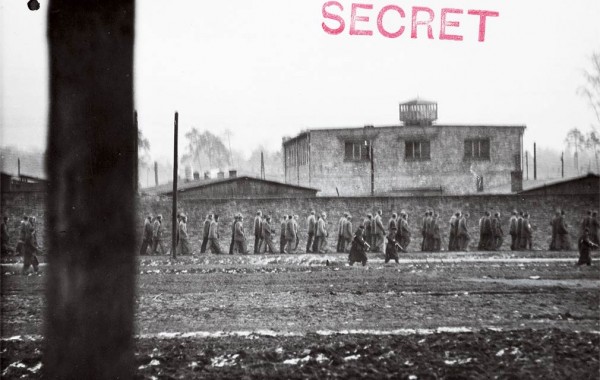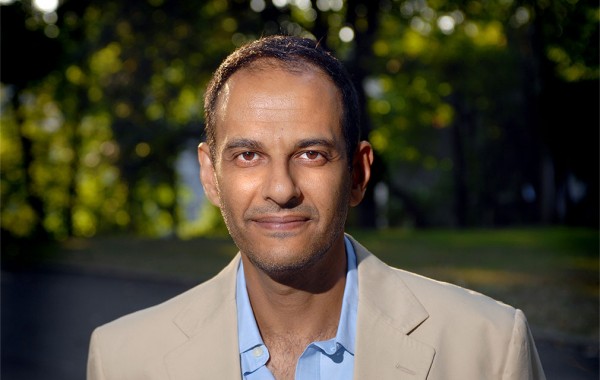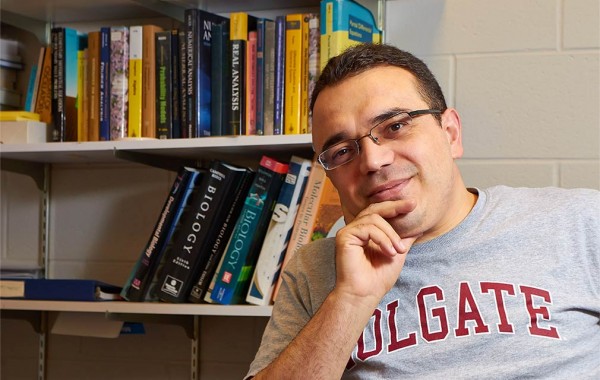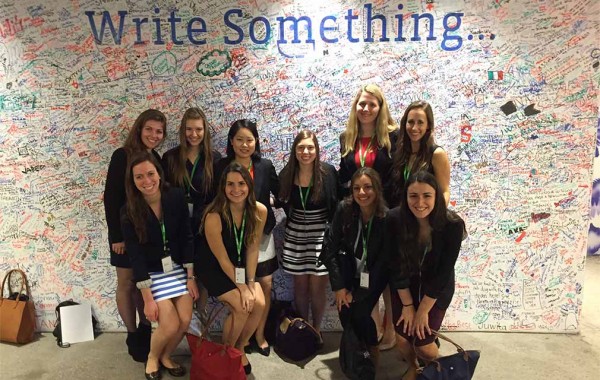Stellar finding
If you are a science fiction buff, you likely recall Luke Skywalker’s home planet Tatooine and the two suns setting on the horizon of a barren landscape. Until recently, Tatooine-like planets that orbit two suns, commonly referred to as circumbinary planets, existed only in the imagination of science fiction writers. But in the past few years, planet hunters using the Kepler Space Telescope have discovered 10 complex planetary systems. The existence of circumbinary planets both challenges and informs astronomers like Jeff Bary, a Colgate physics and astronomy professor whose research seeks to understand the formation of planetary systems.
In collaboration with an international group of astronomers, Bary has made a discovery that provides direct insight into how planets may form in multiple star systems. Using the Atacama Large Millimeter Array in the Chilean desert, the group found direct evidence of what has been dubbed a “planet-forming lifeline” — a stream of gas and dust passing from a large outer disk of material inward toward a much smaller, inner disk surrounding one of three stars in the nearby triple-star system called GG Tau A. The star system, located in the constellation Taurus, is part of a nearby star-forming region some 450 light years from Earth.
The GG Tau A system has been determined to be a few million years old. At this age, and by the rate at which astronomers estimate material is being siphoned gravitationally from the inner disk by the central star, the inner disk should have dissipated long ago. But the existence of the stream has profound implications for the possibility that a planet or planets could have formed or could still be forming in this inner disk. In essence, it’s a possible “lifeline” for any future planets in this system.
In addition, Bary said, the outer disk may be capable of forming a circumtrinary planet, one that would orbit all three stars, making a system slightly more complex than Tatooine’s. In that case, GG Tau A may harbor planets that orbit the singleton star and circumtrinary planets (planets that orbit three suns). A planet with three suns would be a system like no other detected to date.
“For me, the observations of the gas streamer are a glimpse at the complex processes that lead to the formation of one type — albeit a very complex type — of planetary system,” said Bary. “Our group will continue studying the GG Tau A systems and its similarly complicated neighbors in the nearby Taurus-Auriga star-forming region.”
The research team’s paper on the discovery, which appeared in the October 30 issue of Nature, has been widely discussed in the media, including Astronomy Magazine, National Geographic, and Smithsonian.com.
Phones beat drones
Two teams of students, one armed with phones and the other commanding flying drones, squared off in a simulated strategic battle at Colgate’s Bewkes Center in November.
The students were from several classes, including the Peace and Conflict Studies (PCON) course Weapons and War taught by Karen Harpp and Nancy Ries. The simulation was designed to get students thinking about things they were studying in class like terrain, weather, and war planning.
“This was a good test for bringing experiential learning and technology together in order to help students understand some of the complexities of field operations, and the importance of planning and doctrine,” explained professor Jacob Stoil.
The blue team of about 35 students had structure and technology on their side. Kevin Lynch, chief information officer at Colgate and a former U.S. Air Force communication and information officer, helped set up their mobile command center in the back of a U-Haul.
The team was given a Quanum Nova Quad Copter, three GoPro video cameras, four iPads with cell data, three iMacs, a Sky Eye Glider, two portable Wi-Fi hot spots, and access to Adobe Connect to link multiple video feeds and provide alternate communication means.
Before the simulation, Niall Henderson ’16, a PCON major and blue team ground field commander, said, “I’m looking forward to seeing how our plans play out in action, and to see if we can be as flexible as we need to be while maintaining organization.”
In stark contrast, the red team consisted of about 30 students who represented an insurgent-style group that lacked organizational structure and had only the technology they carried. They purposely did no advance planning, and had no strategy until they were on the ground.
“The simulation challenged me to apply the different strategies and methods of mobilization and infiltration that we learned from studying different wars,” said red team member Manny Medina ’17, a sociology and education major.
In times of war and peace, technology has to be reliable in order to make a difference. Within the first 30 minutes, the blue team experienced technical difficulties with the drones, which impacted their communication structure. With little intelligence about the whereabouts of the red team, the blue team abandoned their high-tech headquarters and went into the field. The takeaway from members of the blue team was that technology was great, but there needed to be a backup plan.
The red team won handily, 17 to 4, using just their mobile phones and a GroupMe chat app that allowed for decentralized communication.
Summing up one of the lessons learned, Stoil said, “Technology should be thought of as a gift, not a certainty.”
On Gaza
In the hopes of facilitating a dialogue about Israel and Palestine after the events there last summer, Moustafa Bayoumi, an author and English professor at Brooklyn College, was invited to campus to give his perspective.
His lecture, titled “After Gaza: What are the Prospects for Peace and Justice in Israel and Palestine?” was sponsored by the Program in Middle Eastern and Islamic Studies. Bayoumi focused on the war in the Gaza Strip, its aftermath, and the possibilities for peace in the greater region.
Bayoumi explained what he saw as the flaws with the current negotiations. Specifically, he asserted that politically motivated conversations neglect discussions of human rights.
“We must break the script of thinking that bombing from the air solves almost everything,” he said. “The current siege diminishes the human capacity of Gaza and ultimately the humanity of the Palestinians who live there.”
Having visited Israel, the Gaza Strip, and the West Bank multiple times, Bayoumi emphasized that many voices are left out of the conversation on both sides, and are not portrayed in mainstream American media.
“The vocal political machinery bans the cause of justice and the future of coexistence,” he said. “If we had a conversation based on the people on the ground and on the goodwill of people internationally, we could have a much different conversation.”
Bayoumi also stressed that “people are responsible for their actions,” regardless of their affiliation.
He argued for the need to reset the terms of the dialogue at an institutional level and to find “solutions that guarantee individual and communal rights to all and find justice for all Israelis and Palestinians.”
Bayoumi’s How Does It Feel to be a Problem: Being Young and Arab in America won both an American Book Award and the Arab-American Book Award for Non-Fiction. His commentary has appeared in the New York Times Magazine, the Guardian, the Nation, the Chronicle of Higher Education, and on NPR, CNN, and Fox News.
Several students had the opportunity to continue the conversation with Bayoumi during lunch the next day.
“While I didn’t agree with everything Bayoumi said, I think he really helped clarify some points about Israel and Palestine,” said Ashley Brekke ’16. “I like the idea of looking at the matter as a whole by examining politics as well as culture, history, and religion.”
“The fact that there’s a population [at Colgate] listening and that there’s concern is valuable,” said Bayoumi, noting that college students have the potential to positively change the discourse, but that it can be “a campuswide struggle.”
Campus dialogue about this major international issue continued on October 25 when former Israeli prime minister and president Shimon Peres spoke for the the Kerschner Family Series Global Leaders at Colgate.
— Hannah O’Malley ’17
Professor’s book a “historical masterpiece”

Jaworzno camp in Poland, one of many sites where German-speaking civilians were held into the 1950s.
In October, Professor of History R.M. Douglas flew to Germany to accept a prestigious honor for his book Orderly and Humane: The Expulsion of the Germans After the Second World War. The Georg Dehio Book Prize, funded by the German government, honors exemplary scholarly or literary work that addresses the themes of shared culture and history of the German people and their Eastern neighbors.
Orderly and Humane (2012) chronicles the relocation of German speakers from their birthplaces in Czechoslovakia, Poland, Yugoslavia, Hungary, and Romania to Germany during a five-year period after the Allied powers’ victory in World War II.
“Although [the deportations] occurred within living memory, in time of peace, and in the middle of the world’s most densely populated continent, they remain all but unknown outside Germany itself,” Douglas wrote in a 2012 Chronicle of Higher Education article titled “The European Atrocity You Never Heard About.”
Presented every other year in Berlin, the Dehio Prize was conferred by Günter Winands, the German government’s commissioner for culture and media. Douglas’s work “is more than a historiographical masterpiece,” said Winands. “It is also an appeal against the use of methods inconsistent with human rights as solutions to complex minority problems.”
“The book concerns a very sensitive topic in European history,” said Douglas. “I was especially pleased by the selection committee’s emphasis on the importance of transcending, rather than reopening, the divisions of the past, and am humbled by their assessment that my work contributes, in however small a way, to that goal.”
Orderly and Humane has won several other honors including the American Historical Association’s 2013 George Louis Beer Prize. The Atlantic named it one of 2012’s Books of the Year for 2012.
— Natalie Sportelli ’15
Examining the Ukraine-Russia war
Nancy Ries, professor of anthropology and peace and conflict studies, recently curated a collection of short essays in a series titled “Ukraine and Russia: The Agency of War” for Cultural Anthropology, the top journal in the field.
The journal’s editors-in-chief invited Ries to edit the collection for its “Hot Spots” forum. The series aims to assess the conflict between Ukraine and Russia through multiple voices and perspectives informed by long-term scholarship.
“The war in Russia and Ukraine is as much a war of consciousness and ideologies as it is a war of militias with guns, tanks, and Buk missile launchers,” said Ries in her introduction. “While in no way intending to minimize the physical violence of this war, our task as social observers and cultural theorists has been to create space to consider the significance of this war for social relationships and social contracts, political self-images and constructions of country, sovereignty, and the sacred.”
Cultural Anthropology is the only open source, peer-reviewed journal published by the American Anthropological Association. The collection includes 10 essays from scholars from around the world. “I chose authors I know from the United States, Russia, and Ukraine, trying to balance out disciplines, types of expertise, and perspectives,” said Ries. The articles “explore the complexity (and tragedy) of what is being done and undone in [the Ukraine-Russia] war, the ambivalences of lived reality, and the intangible forms of chaos being contrived in that reality. At the same time, [the] essays capture the everyday refusal of the flattening of memory and social perspective.”
While curating the essays, Ries looked to present objective, scholarly viewpoints on the conflict. “I was very keen to get people to avoid fueling the ideological fires of this ‘war,’” said Ries. “You’ll see that none of these essays takes clear and obvious ‘sides’ with one country or another, but rather, we are trying to rise above the fray.”
— Natalie Sportelli ’15
Biology and math meet computer science
From Ay to Zebrafish, three former students dove into an unexpected experience at Colgate as research assistants — and now, their results have been published in the biology journal Development.
While conducting research on zebrafish, Ahmet Ay, a biology and mathematics professor, needed programmers who could write code at a high level. Computer science majors Jack Holland ’13 and Adriana Sperlea ’14 answered the call, and during the summers of 2012 and 2013, they used a high-level programming language to create models of a specific aspect of embryonic development.
Ay was collaborating with Ertugrul M. Ozbudak of the Albert Einstein College of Medicine. The group’s first paper in Development was published last year, and a second paper was just published in November. Math major Sebastian Sangervasi ’14 also contributed to the second paper.
Holland and Sperlea created models of segmentation — the division of the body into a series of repetitive segments. “Segments in the animal body are determined during early development,” Ay explained. “Problems in this process lead to diseases such as scoliosis. We study the formation of the somites [precursor tissues that give rise to vertebrae of the spine and skeletal muscle] during early development, and try to understand how this process is controlled.”
The periodic segmentation of the somites is controlled by a gene expression oscillator called the vertebrate segmentation clock, Ay explained. Their first study focused on identifying the clock’s pacemaker mechanism. They showed that a gene regulatory network, which includes a negative feedback loop and time delays, controls it, and, using their mathematical model, they were able to reproduce approximately 20 experimental phenotypes (characteristics) in five different genetic backgrounds.
Ay said that during vertebrate embryonic development, the body axis elongates from the posterior in a polarized manner. Strikingly, the period of oscillations varies in cells located at different places in the tissue, which results in traveling waves of oscillation within it. In their second study, they were able to explain the spatial variation of oscillation by increasing the translational time-delay throughout the tissue in a polarized fashion. “Basically, we tried to understand how the somites are forming using mathematical modeling,” explained Ay.
For Holland, working with Ay and the rest of the team opened up a whole new field of study. “Biology has some really cool problems to solve,” he said. “There’s a big demand for programmers and computer scientists who can help with biology, and it was really surprising to me to see that kind of connection.”
Holland is now pursuing computational biology research on proteins at Dartmouth College. Sperlea is in the UCLA Bioinformatics Program, one of the top computational biology programs in the country, and Sangervasi is a software engineering associate at Apptus, a software company that works with online retailers.
Live and learn
During fall break, the Women in Computer Science (WiCS) student group organized a two-day career exploration trip to New York City. The 11 computer science majors visited Bloomberg, Facebook, Shutterstock, ZocDoc, Google, Twitter and Vine, and Foursquare Labs. Here’s what Catherine Seo ’16 (second row, third from left) had to say:
Monday morning, we headed over to Bloomberg. We had breakfast with a few female engineers who talked about how they got into computer science and their early days on the job.
Throughout the day, we toured each company’s facilities. We met female engineers who shared their experiences and answered our questions about the office culture, working environment, and professional development — specifically how their companies encourage and support female employees in technology and engineering.
Each company had a different goal and purpose, and had a different vibe accordingly. For example, Shutterstock, being a photography, footage, and music provider, was modern and sleek.
Seeing the dynamics of these companies and the changes they make in the world got me really excited. I realized that there is endless potential for technology to be an important service. Just look at ZocDoc providing medical assistance to more than 6 million people each month through its website and phone application — which involves a group of engineers coming up with brilliant ideas.
This experience changed my outlook on what I want to do with my life and career. I don’t plan to go to graduate school anymore, but I want to be working straight out of college, implementing my ideas of what I believe to be helpful changes.
Syllabus
PHIL 418A: Life and Death
Brooks Sommerville, Visiting Assistant Professor of Philosophy
MWF 10:20-11:10 a.m., 220 Lawrence
Course description:
This course introduces students to some of the main philosophical issues and debates related to life, death, and mortality. Students will gain an understanding of death’s philosophical significance in ancient, modern, and contemporary philosophy — from Epicurus to Immanuel Kant to Thomas Nagel.
On the Reading List:
Well-Being and Death, Ben Bradley
Confrontations With the Reaper: A Philosophical Study of the Nature and Value of Death, Fred Feldman
Introductory Readings in Ancient Greek and Roman Philosophy, Reeve and Patrick Lee Miller
The professor says:
“Philosophers have a surprisingly difficult time defining death. You might think, for example, that death is simply the cessation of life. But: 1) We must know what ‘life’ means, and defining life proves to be no easier than defining death; 2) There are cases where a thing clearly ceases to be alive, and yet we might not call these cases of death (e.g., suspended animation, fission, fusion).
“We spend a lot of time on the question of whether death is bad for the person who dies — another surprisingly difficult question. Assuming one can give a good argument that death is bad, then this raises a new question: does the claim that death is bad for the person who dies commit one also to the view that immortality would be a good thing?
“Recent developments in the field, particularly in the subfield of bioethics, have generated new interest in the subject and illuminated the defects in traditional approaches.”









